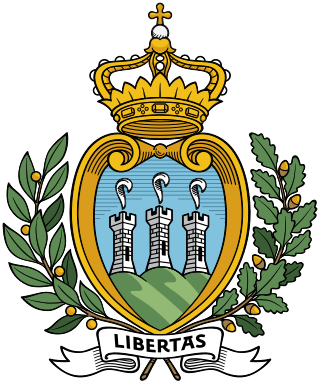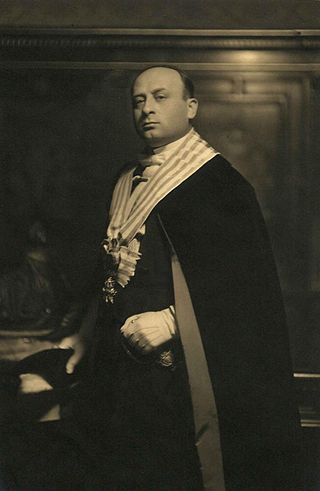
The Sammarinese Christian Democratic Party is a Christian-democratic political party in San Marino.

General elections were held in San Marino on 10 June 2001. The Sammarinese Christian Democratic Party remained the largest party, winning 25 of the 60 seats in the Grand and General Council, and continued their coalition with the Sammarinese Socialist Party.

Giuliano Gozi was Secretary for Foreign Affairs and de facto Fascist leader of San Marino from 1918 until 1943. He also held the role of Captain-Regent of San Marino 5 times between 1923 and 1942.

The Sammarinese Fascist Party or PFS was a fascist political party that ruled San Marino from 1923 to 1943.

The fatti di Rovereta was a constitutional crisis in San Marino in 1957 in which the Grand and General Council was deliberately rendered inquorate to prevent the scheduled election of Captains-Regent. A provisional government was established in the village of Rovereta, in opposition to the outgoing Captains-Regent whose term had expired.

General elections were held in San Marino on 23 June 1912 to elect the third term of the Grand and General Council.

General elections were held in San Marino on 9 June 1918 to elect the fifth term of the Grand and General Council.

General elections were held in San Marino on 14 November 1920 to elect the sixth term of the Grand and General Council. It was the country's first snap election, and the first election to use a form of proportional representation. The result was a victory for the Sammarinese People's Party, which won 29 of the 60 seats.

General elections were held in San Marino on 12 December 1926 to elect the eighth term of the Grand and General Council. It was a sham election, all opposition being prevented to participate by internal and Italian threats. After it had taken over the country in April 1923, the Sammarinese Fascist Party was the only party to contest the elections, winning all 60 seats, while the official report spoke of a sole dissident ballot. A new electoral law guaranteed safe undisputed seats to the two incumbent Captains Regents.

General elections were held in San Marino on 14 August 1955. Although the Sammarinese Christian Democratic Party remained the largest party, winning 23 of the 60 seats in the Grand and General Council, the alliance of the Sammarinese Communist Party and Sammarinese Socialist Party retained its majority.

General elections were held in San Marino on 13 September 1959. The Sammarinese Christian Democratic Party remained the largest party, winning 27 of the 60 seats in the Grand and General Council, and formed a coalition with the Independent Democratic Socialist Party.

General elections were held in San Marino on 7 September 1969. The Sammarinese Christian Democratic Party remained the largest party, winning 27 of the 60 seats in the Grand and General Council, and continued their coalition with the Independent Democratic Socialist Party, together holding 38 of the 60 seats. The Christian Democratic Party had flown in 400 supporters from the United States to vote for them.

General elections were held in San Marino on 8 September 1974. The Sammarinese Christian Democratic Party remained the largest party, winning 25 of the 60 seats in the Grand and General Council, and formed a coalition with the Sammarinese Socialist Party.

General elections were held in San Marino on 28 May 1978. The Sammarinese Christian Democratic Party remained the largest party, winning 26 of the 60 seats in the Grand and General Council. Following the elections the Sammarinese Communist Party formed a coalition with the Sammarinese Socialist Party and the Unitary Socialist Party.

General elections were held in San Marino on 29 May 1983. The Sammarinese Christian Democratic Party remained the largest party, winning 26 of the 60 seats in the Grand and General Council. Following the elections the Sammarinese Communist Party continued their coalition with the Sammarinese Socialist Party and the Unitary Socialist Party.

General elections were held in San Marino on 13 May 1993. The Sammarinese Christian Democratic Party remained the largest party, winning 26 of the 60 seats in the Grand and General Council, and continued their coalition with the Sammarinese Socialist Party.

General elections were held in San Marino on 31 May 1998. The Sammarinese Christian Democratic Party remained the largest party, winning 25 of the 60 seats in the Grand and General Council, and continued their coalition with the Sammarinese Socialist Party.
The Sammarinese People's Party (PPS) was a Christian democratic political party in San Marino, forerunner of the current Sammarinese Christian Democratic Party, and counterpart of the Italian People's Party.
The Sammarinese Democratic Union was a conservative political movement in San Marino and a counterpart of the liberal coalition which ruled Italy before the fascist era.
The Patriotic Bloc was a far-right coalition of parties which ran undisputed in the Sammarinese election of 1923.





